You spent a lot of time researching the perfect harness for your dog, and you chose one based on how comfortable it is. Your dog seems to love wearing its harness, enough that you’ve considered keeping the harness on even when not on walks. Is it okay for a dog to wear a harness all the time?
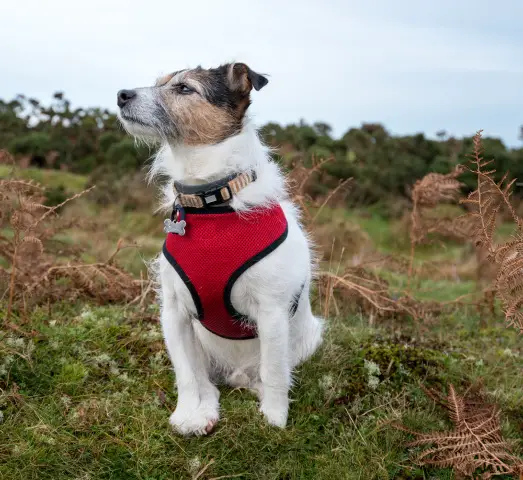
Dogs should wear a harness when training or going on a walk and not all day and night. The only exceptions would be during camping or hiking trips. Prolonged use of a harness can cause shoulder pain, chafing, and eventually issues with the dog’s gait.
In today’s article, we’ll examine the risks of harness overuse. We’ll also delve into the scenarios in which your dog needs a harness and when it doesn’t. There’s lots of great information to come, so make sure you keep reading!
Does a Dog Need to Wear Its Harness All the Time?
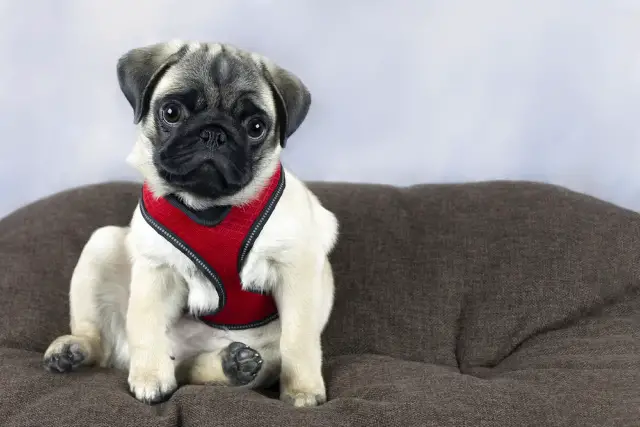
Harnesses are designed to be more comfortable for dogs than collars, as there’s nothing pulling at the dog’s neck, head, or throat. Instead, the harness wraps around the dog’s upper body to about its abdomen.
As handy as a harness is, it’s not an accessory that your dog should wear around the clock. As we’ll discuss later in this article, when your dog wears a harness all day and night, your pet could suffer both short-term and long-term consequences.
Okay, but what if your dog is prone to taking off at a moment’s notice? You worry that without a harness, you won’t be able to grab your dog in enough time to stop them from running away.
A harness is quite grabbable, and some even have handles for just the situation you described. Even still, that is no excuse to keep a harness on a dog for longer than needed.
Your dog will probably be wearing a collar if not a harness. You can always hook a few fingers under the collar to grab your dog.
At the very least, if they have no collar on either, then you can pull your pup by the scruff on the back of its neck.
Dogs never outgrow their scruff, even if there is less of it in adult dogs compared to puppies (that depends on the breed, though).
While you shouldn’t pull an adult dog up by the scruff since it doesn’t support the dog’s weight, in an emergency, it’s okay. Just don’t make a habit of it.
How Long Can You Leave a Harness On?
Dogs can wear a harness for a few minutes to several hours. You should leave your dog’s harness on only as long as needed.
In some situations, you’ll need to keep your dog’s harness on all day whilst in other situations, only a few minutes. It’s best to only keep the harness on as long as you need it to avoid any health issues with your dog.
Can Dogs Sleep with a Harness On?
Dogs can sleep with a harness on but it’s not advisable, especially for young or unsupervised dogs. Harnesses can have buckles that dig into the dog or limit circulation causing the dog pain.
Harnesses can also get caught on something, which could lead to injury in your dog.
Can You Leave a Harness on a Puppy?
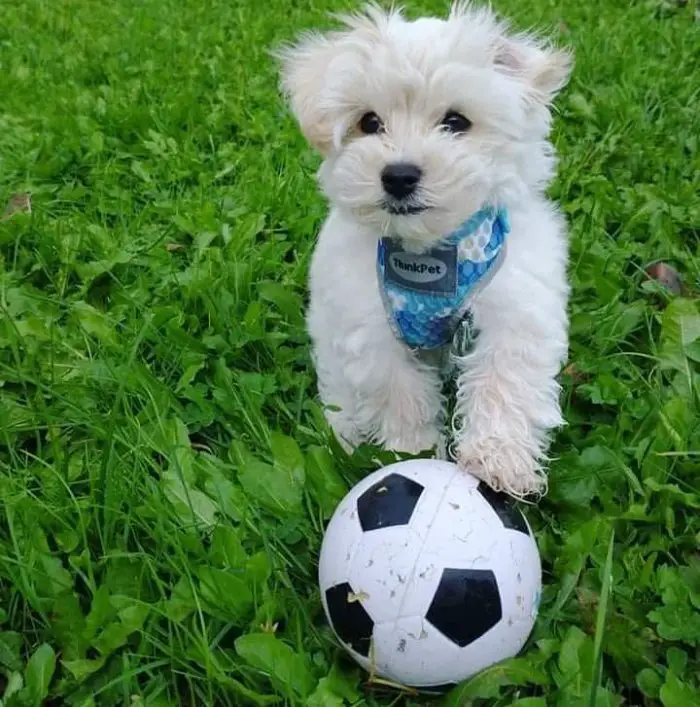
It’s not advisable to leave a harness on a puppy all day or overnight. Like adult dogs, the straps can reduce circulation and restrict movement in the pup. And the buckles and clips can also dig into the dog.
It’s especially important not to leave a puppy with a harness or collar on a night when they are sleeping. It can be a choking hazard. Harnesses and collars can easily get tangled on something. And additionally, puppies like to chew things.
When Your Dog Needs a Harness
Are you not sure which situations are appropriate for a dog to wear a harness? Per the intro, here are some scenarios in which your dog should use its harness.
Keep in mind that your dog only needs the harness until they’re safely back inside the house or otherwise around people they know and are comfortable with. Then the harness should come off.
When Training Outdoors
Unless your backyard is fenced in, then it’s a good idea to put a harness on your dog when doing any kind of outdoor training.
Even with a fence, a harness is a good protective measure. After all, if your dog spots a squirrel while you’re trying to train them at agility, they’ll go rushing off. You’ll chase them to try to catch them, panicked that they’re not wearing a harness. Your dog sees your chasing as a game and might run faster.
When Going to the Bathroom
Your dog is outside to do its business, but that doesn’t mean that a flying bird or a rushing rabbit won’t catch your pup’s eye. The sound of traffic could also spook your dog and send ‘em running, which is also problematic.
I, for one, always take my dog Coco out on a leash for her nightly wee, just before bed.
At night, you can’t tell what’s around you. And it’s quite often she spots something. Like a possum, bird, cat, or something else. Just having it on stops her from running off and she gets her business done faster.
When on a Walk
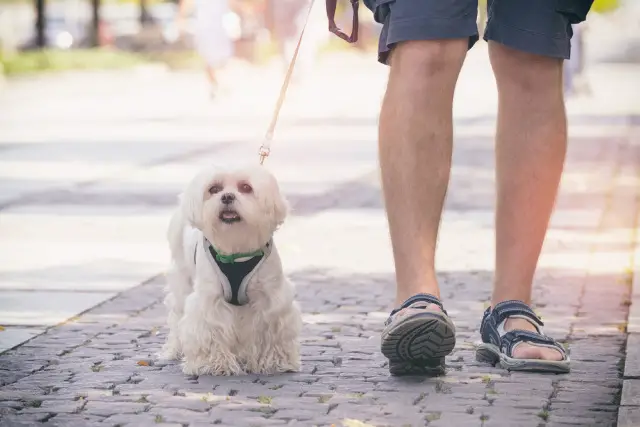
Your dog lives for walk time. For the pup’s safety, you should use a harness and a leash when on walks.
You never know if you’re going to encounter another dog on your walk as well as people or wild animals, all of which can upset your dog. On many occasions, we’ve had other dogs lunge at us, and also our dog Coco lunge for dogs, birds, kids, anything exciting really.
Whether you’re going on a leisurely stroll around the neighborhood, heading out to the dog park, or adventuring somewhere new, a harness on your dog will give you greater peace of mind.
When Camping or Hiking
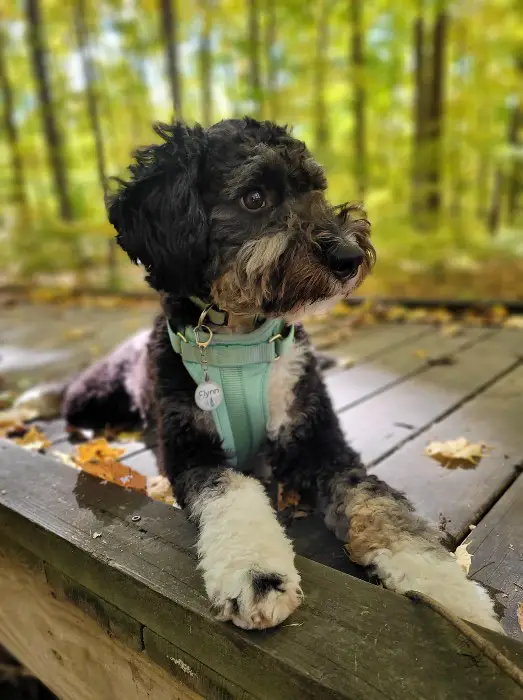
The only time when your dog will use a harness for more than a couple of hours (outside of a very long walk, that is) is when you’re on a camping expedition or hiking for the day.
Being out in the wilderness with your dog is a lot more different than what they or you are used to. If your pup were to get loose, you’d have to worry about them becoming a meal for the ferocious animals that live here.
You also want to be careful in unfamiliar environments that your dog doesn’t run off. Finding your favorite four-legged friend could prove especially challenging.
When Your Dog Doesn’t Need a Harness
There are a lot of instances in which your dog should use a harness or at least a leash, so let’s next talk about when a harness isn’t required.
At Home
Home is the most comfortable place for your dog and also where they’ll spend 90 percent of their time.
You give your pup plush beds and surfaces to rest on, toys to play with, and food to nourish them. Yet, their quality of life is being majorly detracted if you continue to make your dog wear a harness when at home.
There’s simply no need for it.
The doors are closed, so there are only so many places your dog can go. If you don’t want them getting into certain rooms or areas of the home, training them is a much more effective solution than making them wear a harness.
The Risk of Prolonged Harness Use
If you don’t take your dog’s harness off after a day of outdoor activity, they face a myriad of health risks. Let’s go over them now.
Could Cause Choking
Although a harness doesn’t wrap around a dog’s throat, as we talked about before, that doesn’t mean a harness isn’t a choking hazard.
Let’s say your dog sleeps in its harness. If the harness gets caught on a blanket or fabric, then it can pull tight and possibly make it hard for your dog to breathe.
If your dog decides to chew on the harness (more on this momentarily), that too is a choking hazard.
Will Tangle the Dog’s Fur
If your dog only wears a harness for a few minutes at a clip, then you shouldn’t have to worry about tangled, knotted fur.
However, a dog that wears a harness all day and all night is a lot likelier to have matted hair underneath.
You don’t have to fret about this issue with shorter-coated breeds, of course, but for longer-haired dogs, knots, mats, and tangles are disastrous.
Removing a knot can be very painful, causing your dog even more distress. You’ll probably have no choice but to trim out the knot, which can leave your dog with an odd-looking haircut for a few weeks.
That will only inspire you to ramp up the harness used to hide the uneven area of the dog’s fur.
Could Lead to Chafing
Have you ever worn an outfit that chafes throughout the day? Your skin is rubbed raw by the time you get home, and it takes days before you feel better.
Dogs can chafe in much the same way. A harness rubs along the chest, stomach, shoulders, and back, and some can rub underneath the armpits as well.
All that rubbing for hours at a time is surely going to lead to raw, open sores on your poor dog’s skin.
May Cause Bald Spots
Unfortunately, the risks run deeper than that.
A harness rubs, rubs, rubs at the same areas day in and day out, as established. Even if your dog’s skin isn’t rubbed raw, it could be rubbed bald.
These bald areas on your dog’s coat will not grow back until your pup gets a prolonged break from the harness.
Could Cause Shoulder Pain
Dog harnesses are meant to be worn tightly. Depending on just how tight the harness is though, long-term use of the harness could lead to shoulder pain in your poor canine.
Sore shoulders will prohibit your dog from being able to get up as nimbly as they usually do. They won’t show the typical vigor for walks, they won’t play as much, and they might limp or struggle to get around.
Could Destroy the Harness
As we said, your dog could very well chew through the harness until it’s nothing but threads. An anxious dog might feel trapped in the harness and eager to get out, so they destroy it.
If your dog is uncomfortable in the harness, and it’s preventing them from sleeping, that’s another good incentive to chew the thing to bits.
Conclusion
It’s not okay for a dog to wear a harness all day and night. There’s just no need for it except for the odd overnight camping trip here and there.
When at home, you should always take your dog’s harness off. You can keep the pup’s collar on if you wish or take that off as well.
You want your dog to be happy and healthy, and both hinge on them not wearing a harness for longer than required!
Related Reading:
- 11+ Homemade Dog Treat Recipes Your Dog Will Love
- Do Cavapoos Like Long Walks? Answered!
- How Much Exercise Does a Cavapoo Need?
- Are Cavapoos Easy to Train? (Plus Training Tips)
- 9 Dog-Friendly Camping Spots Near Salt Lake City and Provo
- Barrel Chested Dog Breeds Explained
- Is It Dangerous If a Dog Swallows a Human Tooth?
- 8 Ways to Keep Your Dog Cool on Hot Summer Nights
